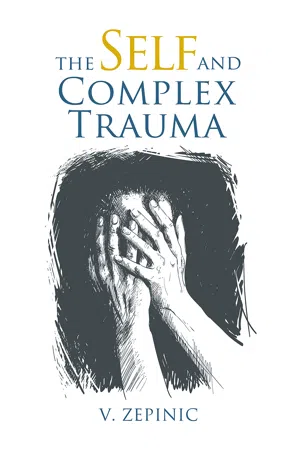Dissociative Disorders
Dissociative disorders are mental health conditions characterized by a disconnection between a person's thoughts, identity, consciousness, and memory. This disconnection can manifest as amnesia, identity confusion, or feeling detached from oneself. Dissociative disorders are often linked to trauma and can significantly impact a person's daily functioning. Treatment typically involves therapy to help individuals integrate their dissociated experiences.
7 Key excerpts on "Dissociative Disorders"
- (Author)
- 2020(Publication Date)
- Wiley(Publisher)
...Dissociative Disorders Steven Jay Lynn 1, Craig P. Polizzi 1, and Scott O. Lilienfeld 2 1 Binghamton University 2 Emory University and University of Melbourne Dissociative Disorders have sparked debate for more than a century. Nevertheless, researchers have made substantial strides in determining their nature and potential antecedents, and theorists have proposed promising but competing accounts of their etiology. Dissociative Disorders and Dissociative Experiences Dissociative Disorders are marked by discontinuities in the “normal integration of consciousness, memory, identity, emotion, perception, body representation, motor control, and behavior” (American Psychiatric Association, 2013, p. 291). Yet people with a dissociative disorder often vary in more ways than they share a uniform symptom profile. Some experience radical alterations in their sense of self and their surroundings, others experience difficulties in their recall of events, and still others experience profound alterations in their sense of identity and abrupt changes in emotions. The DSM‐V provides the following guidelines for diagnosing the three major Dissociative Disorders: Dissociative amnesia is diagnosed in the presence of an inability to recall important autobiographical information, typically of a traumatic or stressful nature, that is inconsistent with ordinary forgetting. This disorder typically “consists of localized or selective amnesia for a specific event or events, or generalized amnesia for identity and life history” (American Psychiatric Association, 2013, p. 298). Depersonalization/derealization disorder, formerly known as depersonalization disorder, is diagnosed based on persistent depersonalization, derealization, or both...
- Amy E. Wenzel(Author)
- 2017(Publication Date)
- SAGE Publications, Inc(Publisher)
...David Spiegel David Spiegel Spiegel, David José R. Maldonado José R. Maldonado Maldonado, José R. Dissociative Disorders: Psychological Factors Dissociative Disorders: Psychological Factors 1152 1155 Dissociative Disorders: Psychological Factors The Dissociative Disorders involve a disturbance in the integration of consciousness, memory, identity, emotion, perception, body representation, motor control, and behavior. Experiences normally connected on a smooth continuum are isolated from one another. This discontinuity results in a variety of Dissociative Disorders depending on the process affected. When memories are poorly integrated, the resulting disorder is dissociative amnesia. If the amnesia also includes apparently aimless wandering, it is considered a subtype, dissociative fugue. Fragmentation of identity results in dissociative identity disorder (DID). Disordered perception of the body or environment results in depersonalization/derealization disorder and in conjunction with the symptoms of posttraumatic stress disorder (PTSD) produces its dissociative subtype. Dissociation of elements of consciousness is also involved in acute stress disorder. Dissociative Disorders represent a disturbance more in the organization of mental contents than in the contents themselves. Memories in dissociative amnesia are not so much distorted or bizarre as they are segregated from one another, impairing retrieval. The aspects of the self that are fragmented in DID are dimensional aspects of an overall personality structure, usually with restricted range of affect and memory. The problem is the failure of integration rather than the contents of the fragments. Dissociative Disorders have in common a lack of immediate access to the entire store of memories, emotions, and perceptual processing...
- eBook - ePub
- Ann Brown(Author)
- 2020(Publication Date)
- Page Publishing, Inc.(Publisher)
...A person with dissociative identity disorder will have two or more separate identities that each has their own way of thinking and relating to the world. To have this disorder, a minimum of two of these identities must also take control over the person’s behavior again and again. Finally, the person with dissociative identity disorder may also have difficulty remembering personal information that, like dissociative amnesia, goes beyond simple forgetfulness. Depersonalization disorder: In depersonalization disorder, a person feels “detached from” their thoughts or body. For example, they may feel as though they are floating outside their body, looking at people through a window, or in a dream. Despite these experiences though, the person still stays in touch with reality. Dissociative disorder not otherwise specified : This term is used by the DSM-IV to describe a dissociative disorder where the main feature is still some kind of dissociative experience, but criteria for other Dissociative Disorders are not present. People with PTSD also may be more likely to have a dissociative disorder. For example, a study of 628 women from the general community found that, of those with a dissociative disorder (the most common of which was dissociative disorder not otherwise specified, followed by dissociative amnesia), 7% also had a PTSD diagnosis. Abreaction : The discharge of energy or emotion involved in recalling an event that has been repressed because it was consciously intolerable. The experience may be one of reliving the trauma as if it were happening in the present, complete with physical as well as emotional manifestations (also called revivification). A therapeutic effect sometimes occurs through partial discharge of or desensitization to the painful emotions and increased insight...
- Craig W. LeCroy, Jane Holschuh, Craig W. LeCroy, Jane Holschuh(Authors)
- 2012(Publication Date)
- Wiley(Publisher)
...10 Dissociative Disorders INTRODUCTION More than one piece of literature or film has portrayed characters with the symptoms of Dissociative Disorders as part of the story plot to create suspense or to illustrate the dramatic impact of early childhood trauma on the development of psychological problems. Many of us remember Gregory Peck in Spellbound (1945) as the lead character who has amnesia—and how the film’s engaging plot was built around it, with Ingrid Bergman as the dedicated colleague and lover who insists on his illness and innocence. Those of us who have seen Three Faces of Eve (1957) will never forget Joanne Woodward’s Oscar-winning portrayal of Eve, a woman who has a “split personality”—and Lee J. Cobb as the psychiatrist who helps her. Sally Field won an Emmy for her performance as a young woman with split or multiple personalities in Sybil, a made-for-TV movie based on a shocking but true story. Today, these problems would be classified under the DSM-IV-TR section on Dissociative Disorders, with little being said in the manual about the etiology or origins of them. What are dissociative states? Are they always a sign of pathology? Most of us from time to time have had a few moments in which we blanked out or spaced out when someone was talking to us or we were listening to a lecture or a speech. This seems normal enough, and we might not remember what was said or done, but we are aware of this lapse in attention. The DSM-IV-TR defines Dissociative Disorders as disturbances in the normally integrative functions of consciousness, identity, memory, or perception that cause distress or impaired functioning (an exception is dissociative identity disorder). Dissociative states that are acceptable and common parts of cultural, spiritual, or religious activities, practices, or experiences are not viewed as pathological if valued and shared by the group involved...
- eBook - ePub
Healing the Fragmented Selves of Trauma Survivors
Overcoming Internal Self-Alienation
- Janina Fisher(Author)
- 2017(Publication Date)
- Routledge(Publisher)
...CHAPTER 8 Treatment Challenges: Dissociative Systems and Disorders “Dissociation is the essence of trauma. The overwhelming experience is split off and fragmented so that the emotions, sounds, images, thoughts and physical sensations related to the trauma take on a life of their own. The sensory fragments of memory intrude into the present, where they are literally relived. As long as the trauma is not resolved, the stress hormones the body secretes to protect itself keep circulating, and the defensive movements and emotional responses keep getting played out.” (Van der Kolk, 2014, p. 66) “The concept of a single, unitary ‘self’ is as misleading as the concept of a single unitary ‘brain.’ The left and right hemispheres process information in their own unique fashion and represent a conscious left brain self system and an unconscious right brain self system.” (Schore, A., 2011, p. 76) In the 1950s, what was then called “multiple personality disorder” came to the attention of mental health professionals initially through books such as The Three Faces of Eve and Sybil. It was controversial and much disputed then, and today, Dissociative Disorders are still the subject of controversy. Even before therapists encounter a dissociative identity disorder (DID) client, they will have been affected by the anxiety and even hostility raised by any mention of the diagnosis among mental health professionals. The “countertransference” reaction to the idea that individuals can have multiple consciousness, parts with separate identities or separate lives often pits psychiatrists (least likely to believe such disorders exist) against psychologists and psychotherapists who have evidence that it does because they have encountered its distinctive symptoms and presentation. Since the 1950s, Dissociative Disorders have often been assumed to be “factitious disorders,” an assumption that is rarely questioned—and rarely documented...
- eBook - ePub
Rhythms of Recovery
Trauma, Nature, and the Body
- Leslie E. Korn(Author)
- 2012(Publication Date)
- Routledge(Publisher)
...The more distressing and debilitating experiences of not remembering either recent or distant past events, such as not knowing how you ended up in a certain location or with a particular pair of shoes in the closet, or whether or not you attended your high school graduation, occur under more severe conditions of dissociation. This severe type of dissociation generally forms a nexus of symptoms called dissociative identity disorder (DID) (formerly called multiple personality disorder—MPD). I do not explore DID in depth here but refer the reader to the work of Chu (2011), Putnam (1989), Barach (1994), Phillips and Frederick (1995), and Boon, Steele, and van der Hart (2011). Dissociation is both an experience and a description of a mechanism (Kirmayer, 1994) underlying five core symptoms including amnesia, depersonalization, derealization, identity confusion, and identity alteration (Steinberg, 1994). The Dissociative Disorders are generally classified as dissociative amnesia, dissociative fugue, dissociative identity disorder, and depersonalization disorder. Dissociative disorder not otherwise specified (DDNOS) includes those individuals who do not fulfill complete criteria for the other categories. This category is being proposed as unspecified dissociative disorder for the DSM-V and would include dissociative trance disorder. Amnesia Amnesia is the absence from memory of a specific and significant segment of time. Dissociative amnesia is not ordinary forgetting. It is useful to distinguish sleep and hypnotic amnesia from conditions that affect identity and memory of large time segments (Steinberg, 1994). Selective amnesia is a failure to recall events from a specific time period. Localized amnesia involves a complete failure of recall for a specific time. Continuous amnesia is a failure to recall events from a specific time up until the present. Generalized amnesia consists of a loss of memory for one’s entire life (Steinberg, 1994)...
- eBook - ePub
- V. Zepinic(Author)
- 2019(Publication Date)
- Austin Macauley Publishers(Publisher)
...However, still many clarifications about DID remains uncertain and the hiddenness of the symptoms requires a further research and evaluation. Putnam et al., (1986) stated that DID (formerly Multiple Personality Disorder) is a syndrome that contains all principal elements of major Dissociative Disorders as patient will, at times, manifest psychogenic amnesia, fugue episodes and profound depersonalisation. What is also important is a fact that this disorder is commonly a chronic state and does not appear to be a self-limited. If untreated, disorder may become a lifetime process and manifest itself through the entire life of the individual. Individuals with DID experience gaps in memory for personal history, both remote and recent. The amnesia depends on the severity of altered personality; the more passive primary identity tends to have more constricted memory and more active alter personality impose more hostile, controlling identity having more complex memories. The identity which is not controlled by primary personality may nonetheless lose access to consciousness. There may be loss of memory not only for recurrent period of time, but also an overall loss of biographical memory for some extended period of time. The time to switch from primary into alter personality is a matter of seconds but also can be a gradual. Behaviour that can indicate switches usually includes rapid blinking, facial changes, changes in voice or demeanour, or disruption in the individual’s train of thoughts (APA, 2013). Dissociative Identity Disorder appears as one of the most unusual mental condition as existence of separate and autonomous alter personality, exchanging control over two personalities in the same body or their hostile relations, is so frightening and mystical that clinical practice is quite common in many dilemmas about diagnosis and treatment of DID...






